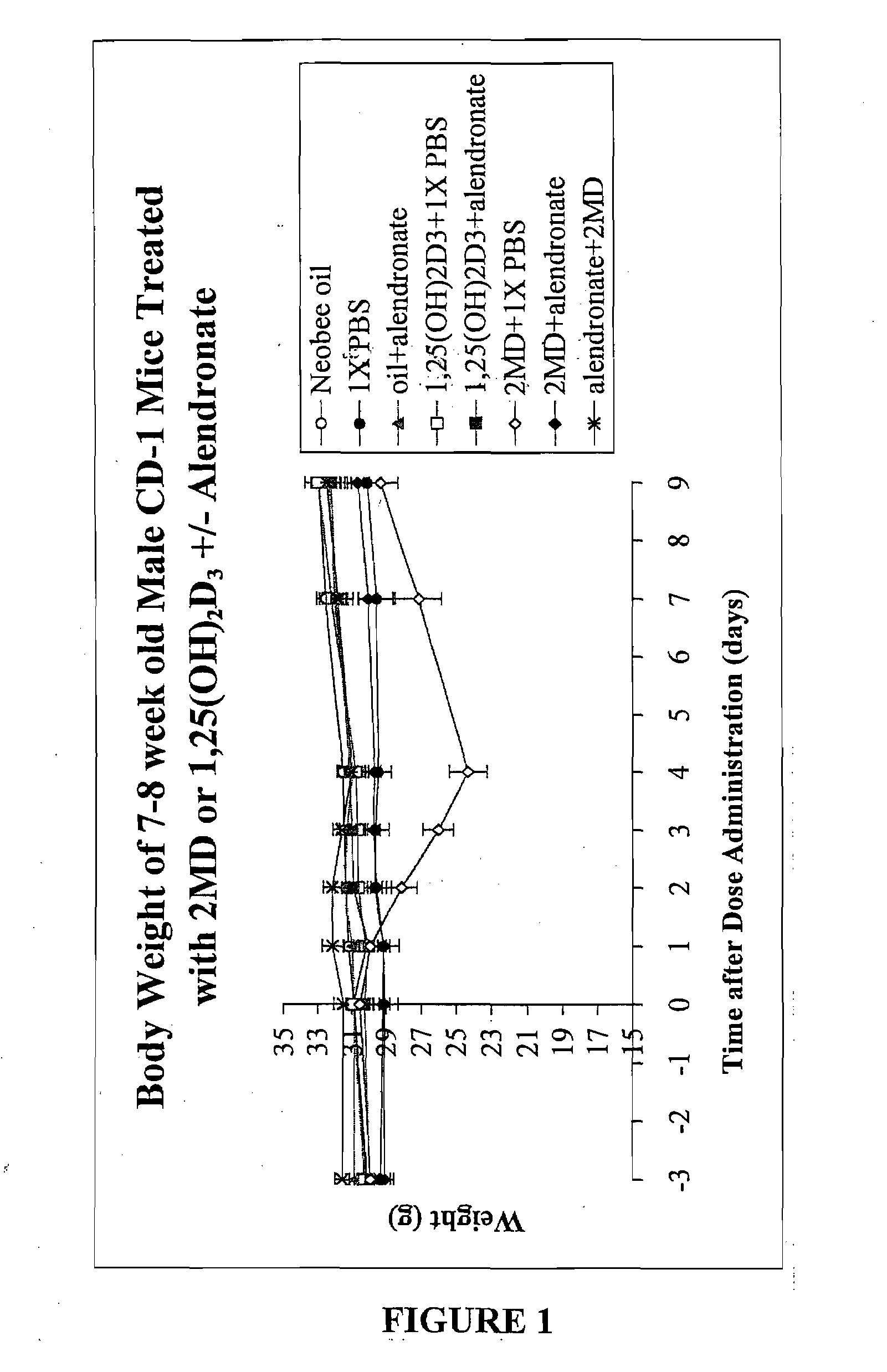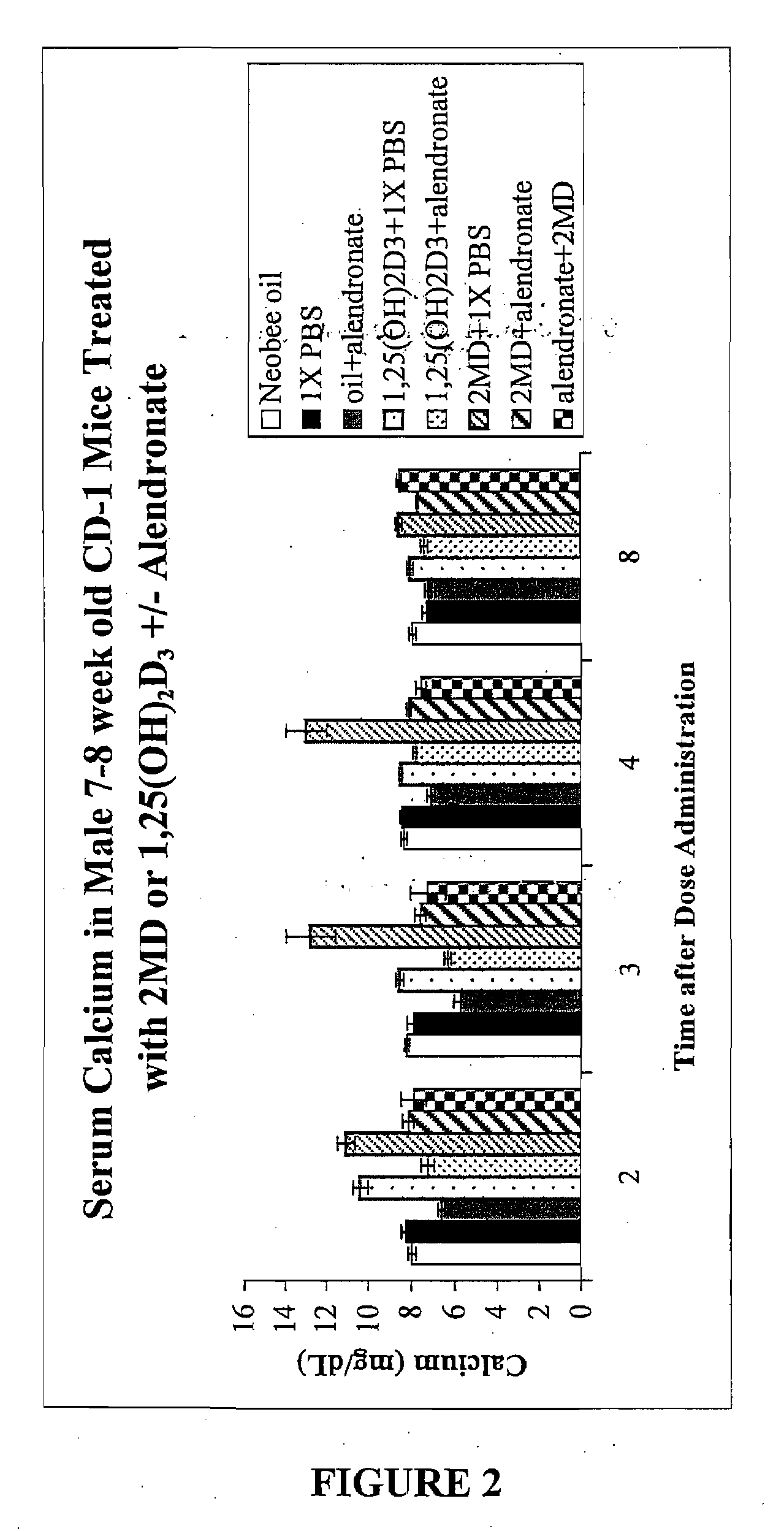Method of Extending the Dose Range of Vitamin D Compounds
a technology dose ranges, applied in the field of extending the dose range of vitamin d compounds, can solve the problems of vitamin d intoxication, analogs are non-calcemic, kidney failure or failure of important organs, etc., and achieves the effects of preventing or preventing or at least minimizing the mobilization of calcium from bone, rapid metabolism and rendering
- Summary
- Abstract
- Description
- Claims
- Application Information
AI Technical Summary
Benefits of technology
Problems solved by technology
Method used
Image
Examples
example 1
[0106]Eight-week-old male CD1 mice were obtained from Harlan-Sprague Dawley and fed purified diet 11 containing 0.47% calcium, 0.3% phosphorus, and supplemented with vitamins A,D,E and K as described by Suda et al, “Biological Activity of 25-Hydroxyergocalciferol in Rats,” J. Nutrition, Vol. 100, pp. 1049-1052 (1970). Two days after arrival, the rats were then transferred to the same diet 11 but containing 0.02% calcium, 0.3% phosphorus, and the A,D,E and K supplement. Thus, the animals were on a diet essentially devoid of calcium. Two days following shifting of the animals to the low calcium diet, they were given the following doses: 1.7 μg / kg bw and / or 4.5 μg / kg bw 2MD or 500 μg / kg bw 1,25-(OH)2D3. The mice were first divided into 6 / group and provided the vitamin D compounds by oral administration at the dose levels shown. Alendronate which was obtained from Sigma was dissolved in phosphate-buffered saline and given interperitoneally in a volume of 100 μL. Serum was collected on d...
example 2
[0117]The animals (7-8 week old mice) were received from Harlan Sprague Dawley and were provided the usual purified diet 11 of Suda et al (see Example 1). The mice were then divided into two groups: one group continued to receive the diet 11 containing 0.47% calcium, 0.3% phosphorus. This is considered to be a normal or adequate calcium intake diet. The second group received the same diet 11 except the calcium was removed, leaving a calcium level of not more than 0.02% and a 0.3% phosphorus level. After both groups of animals were acclimatized on their respective diets for at least a week, they were further divided and given the following: one group received the Neobee oil orally which is used as a carrier for the vitamin D analog (2MD). Another group received an interperitoneal dose of phosphate buffered saline, termed PBS. Another group received 1.75 mg of alendronate / kg body weight in the PBS and also received the oral administration of the Neobee oil. Another group received the ...
PUM
| Property | Measurement | Unit |
|---|---|---|
| concentration | aaaaa | aaaaa |
| weight | aaaaa | aaaaa |
| volume | aaaaa | aaaaa |
Abstract
Description
Claims
Application Information
 Login to View More
Login to View More - R&D
- Intellectual Property
- Life Sciences
- Materials
- Tech Scout
- Unparalleled Data Quality
- Higher Quality Content
- 60% Fewer Hallucinations
Browse by: Latest US Patents, China's latest patents, Technical Efficacy Thesaurus, Application Domain, Technology Topic, Popular Technical Reports.
© 2025 PatSnap. All rights reserved.Legal|Privacy policy|Modern Slavery Act Transparency Statement|Sitemap|About US| Contact US: help@patsnap.com



